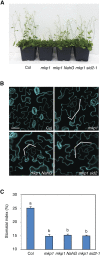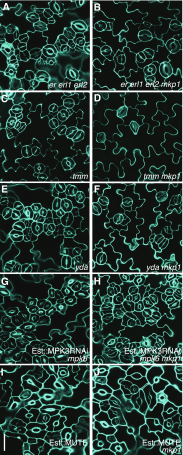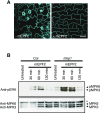MAP KINASE PHOSPHATASE1 Controls Cell Fate Transition during Stomatal Development
- PMID: 30002258
- PMCID: PMC6130035
- DOI: 10.1104/pp.18.00475
MAP KINASE PHOSPHATASE1 Controls Cell Fate Transition during Stomatal Development
Abstract
Stomata on the plant epidermis control gas and water exchange and are formed by MAPK-dependent processes. Although the contribution of MAP KINASE3 (MPK3) and MPK6 (MPK3/MPK6) to the control of stomatal patterning and differentiation in Arabidopsis (Arabidopsis thaliana) has been examined extensively, how they are inactivated and regulate distinct stages of stomatal development is unknown. Here, we identify a dual-specificity phosphatase, MAP KINASE PHOSPHATASE1 (MKP1), which promotes stomatal cell fate transition by controlling MAPK activation at the early stage of stomatal development. Loss of function of MKP1 creates clusters of small cells that fail to differentiate into stomata, resulting in the formation of patches of pavement cells. We show that MKP1 acts downstream of YODA (a MAPK kinase kinase) but upstream of MPK3/MPK6 in the stomatal signaling pathway and that MKP1 deficiency causes stomatal signal-induced MAPK hyperactivation in vivo. By expressing MKP1 in the three discrete cell types of stomatal lineage, we further identified that MKP1-mediated deactivation of MAPKs in early stomatal precursor cells directs cell fate transition leading to stomatal differentiation. Together, our data reveal the important role of MKP1 in controlling MAPK signaling specificity and cell fate decision during stomatal development.
© 2018 American Society of Plant Biologists. All rights reserved.
Figures








Similar articles
-
MKP1 acts as a key modulator of stomatal development.Plant Signal Behav. 2019;14(7):1604017. doi: 10.1080/15592324.2019.1604017. Epub 2019 Apr 13. Plant Signal Behav. 2019. PMID: 30983545 Free PMC article.
-
Mitogen-Activated Protein Kinase Phosphatases Affect UV-B-Induced Stomatal Closure via Controlling NO in Guard Cells.Plant Physiol. 2017 Jan;173(1):760-770. doi: 10.1104/pp.16.01656. Epub 2016 Nov 11. Plant Physiol. 2017. PMID: 27837091 Free PMC article.
-
Stomatal development and patterning are regulated by environmentally responsive mitogen-activated protein kinases in Arabidopsis.Plant Cell. 2007 Jan;19(1):63-73. doi: 10.1105/tpc.106.048298. Epub 2007 Jan 26. Plant Cell. 2007. PMID: 17259259 Free PMC article.
-
Take a deep breath: peptide signalling in stomatal patterning and differentiation.J Exp Bot. 2013 Dec;64(17):5243-51. doi: 10.1093/jxb/ert246. Epub 2013 Aug 30. J Exp Bot. 2013. PMID: 23997204 Review.
-
Stomatal development in the context of epidermal tissues.Ann Bot. 2021 Jul 30;128(2):137-148. doi: 10.1093/aob/mcab052. Ann Bot. 2021. PMID: 33877316 Free PMC article. Review.
Cited by
-
Mitogen-activated protein kinase phosphatase 1 controls broad spectrum disease resistance in Arabidopsis thaliana through diverse mechanisms of immune activation.Front Plant Sci. 2024 Mar 21;15:1374194. doi: 10.3389/fpls.2024.1374194. eCollection 2024. Front Plant Sci. 2024. PMID: 38576784 Free PMC article.
-
Molecular Mechanisms for Regulating Stomatal Formation across Diverse Plant Species.Int J Mol Sci. 2024 Sep 27;25(19):10403. doi: 10.3390/ijms251910403. Int J Mol Sci. 2024. PMID: 39408731 Free PMC article. Review.
-
MAP kinase cascades in plant development and immune signaling.EMBO Rep. 2022 Feb 3;23(2):e53817. doi: 10.15252/embr.202153817. Epub 2022 Jan 18. EMBO Rep. 2022. PMID: 35041234 Free PMC article. Review.
-
Chemical genetics reveals cross-activation of plant developmental signaling by the immune peptide-receptor pathway.bioRxiv [Preprint]. 2024 Jul 30:2024.07.29.605519. doi: 10.1101/2024.07.29.605519. bioRxiv. 2024. Update in: Sci Adv. 2025 Feb 07;11(6):eads3718. doi: 10.1126/sciadv.ads3718. PMID: 39131359 Free PMC article. Updated. Preprint.
-
Shouting out loud: signaling modules in the regulation of stomatal development.Plant Physiol. 2021 Apr 2;185(3):765-780. doi: 10.1093/plphys/kiaa061. Plant Physiol. 2021. PMID: 33793896 Free PMC article. Review.
References
-
- Andreasson E, Ellis B (2010) Convergence and specificity in the Arabidopsis MAPK nexus. Trends Plant Sci 15: 106–113 - PubMed
-
- Bartels S, González Besteiro MA, Lang D, Ulm R (2010) Emerging functions for plant MAP kinase phosphatases. Trends Plant Sci 15: 322–329 - PubMed
-
- Bergmann DC, Lukowitz W, Somerville CR (2004) Stomatal development and pattern controlled by a MAPKK kinase. Science 304: 1494–1497 - PubMed
MeSH terms
Substances
LinkOut - more resources
Full Text Sources
Other Literature Sources
Molecular Biology Databases
Miscellaneous

